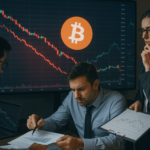The use of artificial intelligence (AI) in Bitcoin (BTC) and cryptocurrency trading is changing the way traders analyze, interpret, and make decisions in the market.
Three analysts surveyed by CriptoNoticias believe that AI-powered tools integrate new information sources; Process large amounts of data in real timeThis allows trends to be predicted with an accuracy that until recently was not achievable with traditional human analysis.
Rodrigo Duran Guzmán, communications director at Chilean exchange CryptoMKT, explains that AI is revolutionizing the analysis of the Bitcoin market by combining on-chain information, sentiment on social networks, derivatives movements, order book data, and macroeconomic indicators.
According to experts, this Create a “broader understanding” of context Automate decisions faster. “AI models process data in milliseconds and provide results with defined levels of probability and uncertainty. Traders no longer rely solely on chart interpretation, but on models that learn and evolve,” he points out.
Argentine technical analyst Emmanuel Juarez argues: AI will transform market analysis Bitcoin Because we can now process large amounts of information and detect patterns and fluid flows in seconds. “It used to require hours of observation,” he recalls. “Today it happens in real time,” he added.
“Furthermore, it reduces the emotional component of traders, which is one of the most difficult factors to control in the market,” Juarez said. AI will not replace technical analysis, but it will “enhance it by increasing objectivity and speed in reading the market.”
Similarly, Daniel Andres Pelaez, a Venezuelan expert on P2P trading, agrees: AI “represents a structural change in operations” in the market of cryptocurrencies. This highlights that algorithms based on deep learning and natural language processing analyze information in real-time and perform automated operations based on emerging trends.
“These tools combine technical indicators and social media sentiment to increase accuracy and reduce human error. They also detect anomalies, measure volatility, and dynamically adapt to market conditions,” he explains.
Pelaez emphasizes that some AI models have reached accuracy levels of 80% or more for medium-term predictions, but clarifies that: This does not imply absolute accuracy.
“AI has unpredictable factors that cannot be predicted, which is why we should not overestimate their information. It has value, but requires continuous validation,” he warns.
In this order, Duran added that while AI improves predictive ability, it “cannot remove the uncertainty of a volatile market like Bitcoin.”
“The value lies not in speculating on prices, but in better managing volatility, detecting early opportunities, and reducing errors. Perfect forecasting is a myth. “What AI provides is a real statistical advantage,” he says. According to experts, the strength of automated analysis lies in its ability to handle multiple variables and find hidden correlations. This allows traders to operate with more contextual information.
Advantages and limitations of automated analysis
Regarding its advantages over traditional methods, the three analysts agree that AI overcomes the limitations of linear technical analysis. They point out that the algorithm learns from historical data, identifies patterns invisible to the human eye, and generates signals based on the relationships between price, sentiment, and volume. they say, It provides a level of discipline and consistency that reduces subjectivity.
Juarez explained that, unlike manual approaches, algorithmic models “eliminate a lot of the emotional bias.” This is an aspect that has historically influenced decision-making in trading.
However, they all warn about the risks of relying completely on automated systems. For example, Duran believes that delegating decisions without oversight can amplify mistakes. Especially when faced with unexpected events or liquidity crises..
“Algorithms can overfit historical data and fail in new scenarios. Additionally, some models are complex, so their decisions are difficult to understand, which can lead to operational failures and losses due to leverage,” he explains. It also mentions technical risks such as data interruptions and connection failures. If there is no limit or automatic stop mechanism, losses may occur.
Pelaez also warned against traders’ “overreliance” on AI results. “Successful algorithms can reduce critical operator judgment and create blind spots. If the input information is incorrect or biased, the predictions will change,” he points out.
“Furthermore, a lack of transparency in AI decisions can cause significant losses,” he says, believing that the use of these tools: Requires balance between automation and human controlIn addition to ongoing risk assessment.
Mr. Juarez believes that automated systems Unable to predict market sentiment yetis a key factor in price formation.
“The[Bitcoin]market is 90% emotional, and algorithms cannot accurately interpret those variables, which is why human oversight remains essential,” he points out. In the face of algorithmic decisions, you assume the role of guide rather than spectator.
The role of traders in the face of automation
As for the future of AI-powered trading, experts predict that traders and innovative technologies will coexist more closely. Duran believes that future traders will need to be able to interpret models, understand data sources, and better manage risk.
“The role becomes more strategic and less impulsive. It is important to understand the macroeconomic situation, design clear rules and monitor model performance, not just read graphs,” he points out.
Pelaez recommends implementing continuing education aimed at understanding how operators function. bot Trading platform and no-code platform. In fact, it suggests Proceed with caution and don’t rush to introduce new tools..
“It’s important to observe first, test in a controlled environment, and move forward based on the results. When it comes to money, you have to tread carefully,” he says.
Juarez agrees that AI will not replace traders. But it serves as an ally to optimize decision-making and better manage risk.
“Traders of the future will not be competing with artificial intelligence, but will need to be trained in the technology and analytics to use it as leverage. AI will allow us to process information faster, but strategies will continue to rely on human judgment,” he concludes.
paradigm shift
In fact, the integration of artificial intelligence in trading Demonstrates a paradigm shift in the cryptocurrency ecosystem. Automated systems are already able to combine multiple information sources to perform operations with minimal human intervention. We saw this recently in the Alpha Arena experiment.
But the warning is more than clear. Analysts agree that the effectiveness of using AI in trading depends on control, validation, and continuous monitoring.
While it’s true that AI is redefining market analysis, the final decision remains in the hands of operators, real humans who know when to intervene and how to manage risk. and the extent to which control is delegated to computer algorithms.










